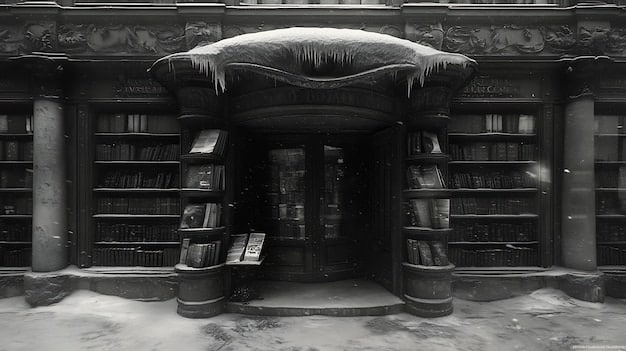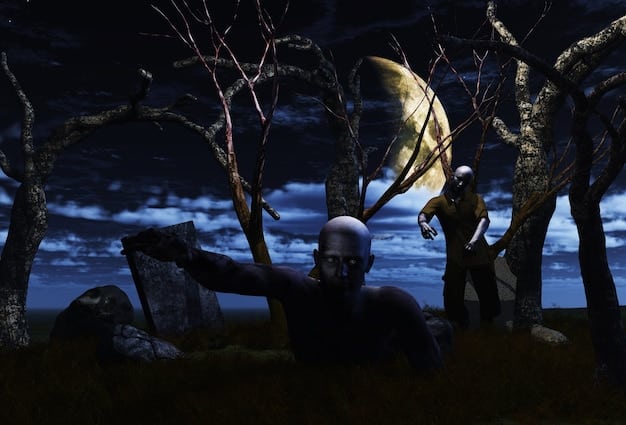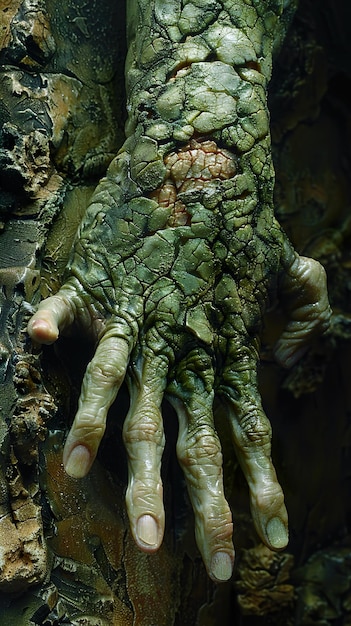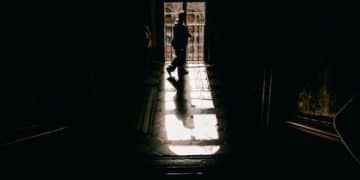Exploring Horror’s Subgenres: The Most Terrifying Reads Today

Horror’s subgenres offer diverse avenues for fear, ranging from psychological thrillers that exploit mental unease to splatterpunk novels drenched in gore, catering to varied tastes and nightmare preferences.
Dive into the chilling world of horror’s subgenres, where every reader can find a unique brand of terror to haunt their dreams.
Unveiling the Many Faces of Fear: An Introduction to Horror Subgenres
Horror, as a genre, is vast and varied. It’s not just about jump scares and monsters under the bed. It’s a landscape of fear, with unique territories that cater to different phobias and anxieties. Understanding these diverse subgenres enhances the reading experience, allowing fans to pinpoint the kinds of stories that truly make their blood run cold.
Exploring the nuances of horror is like embarking on a journey through the darkest corners of human imagination. Each subgenre offers a distinct flavor of dread, from the creeping unease of psychological horror to the visceral shocks of body horror. Let’s begin dissecting the most terrifying subgenres in horror novels today.
Psychological Horror: The Mind is the Scariest Place
Psychological horror delves into the human psyche, exploring the darkest aspects of the mind. It’s less about overt violence and more about creating a sense of unease and dread through mental and emotional instability.
This subgenre often features unreliable narrators, distorted realities, and an exploration of themes like paranoia, guilt, and repressed trauma. The true horror lies not in the external threats, but in the internal conflicts and distorted perceptions of the characters.
Key Elements of Psychological Horror
Characters in psychological horror are often isolated, vulnerable, and grappling with inner demons. Atmosphere plays a crucial role, with settings designed to enhance the sense of claustrophobia and unease.
- Unreliable Narrators: Characters whose perception of reality is skewed or distorted, leaving the reader questioning everything.
- Atmospheric Tension: Creating a palpable sense of dread through vivid descriptions and unsettling imagery.
- Internal Conflict: Focusing on the character’s mental and emotional struggles rather than external threats.
Psychological horror masterfully manipulates the reader’s expectations, playing on their fears and anxieties. It’s a subgenre that lingers long after the final page is turned, prompting introspection and unease.
Supernatural Horror: When Reality Bends
Supernatural horror introduces elements that defy the natural world, such as ghosts, demons, and other entities beyond scientific understanding. It explores the realm of the unknown and the unexplainable, often questioning the very fabric of reality.
This subgenre taps into primal fears of the unseen and the uncontrollable. It often involves themes of good versus evil, the battle for souls, and the consequences of tampering with forces beyond human comprehension.

Consider the implications of a world overrun by forces beyond human control. What if every creak in the night was more than just settling wood? What if the shadows held more than just darkness?
Classic Tropes in Supernatural Horror
Supernatural horror relies heavily on established tropes to create a sense of familiarity and unease. These tropes often involve haunted houses, possession, and other manifestations of the paranormal.
- Haunted Locations: Places imbued with a dark history or lingering spirits, serving as focal points for paranormal activity.
- Demonic Possession: The invasion and control of a human body by a malevolent entity.
- The Occult: The exploration of forbidden knowledge and practices, often with dire consequences.
Supernatural horror succeeds by creating a sense of vulnerability and helplessness. It reminds us that there are forces in the universe that we cannot control or comprehend, leaving us questioning our place in the world.
Slasher Horror: The Thrill of the Chase
Slasher horror is characterized by a relentless killer stalking and murdering a group of victims, often in gruesome fashion. It’s a visceral and suspenseful subgenre that focuses on the cat-and-mouse game between the killer and the survivors.
This subgenre preys on the fear of being hunted and the primal instinct for survival. It often features a high body count, creative kills, and a masked or otherwise enigmatic killer with a distinct motive.
The key lies in the anticipation. The audience knows the killer is out there, lurking in the shadows, ready to strike. This creates a constant sense of dread and suspense, making every scene a potential moment of terror.
Slasher horror may seem formulaic. However, it is in this repetition that its true power comes to life. As readers delve into this horror realm, they may find themselves gripping the pages, urging characters to flee or fight, and all the while dreading the inevitable demise.
Body Horror: Fear of the Flesh
Body horror explores the grotesque and disturbing transformations of the human body. It delves into themes of disease, mutation, and the violation of physical boundaries, often evoking feelings of disgust and revulsion.

This subgenre taps into primal fears of physical vulnerability and the loss of control over one’s own body. It challenges our perceptions of beauty and normalcy, forcing us to confront the unsettling reality of decay and transformation.
Exploring the Physical Uncanny
Body horror often features graphic depictions of bodily decay and mutation, pushing the boundaries of what readers can stomach. It draws on scientific and medical anxieties, exploring the potential for technology and disease to warp the human form.
- Mutation: Physical transformations caused by illness, genetic manipulation, or exposure to toxic substances.
- Parasitism: The invasion and consumption of a host body by a parasitic organism.
- Surgery and Experimentation: Disturbing procedures that violate the integrity of the human body.
Body horror serves to expose the fragility of the human form. By distorting and corrupting our bodies, it questions our sense of self and our place in the natural world. It is a visceral and unsettling subgenre that forces us to confront our own mortality.
Gothic Horror: Where Atmosphere Breeds Terror
Gothic horror combines elements of romance, mystery, and the supernatural, set against a backdrop of decaying castles, isolated mansions, and oppressive landscapes. It creates a sense of foreboding and dread through its atmospheric settings and emotional intensity.
This subgenre explores themes of isolation, decay, and the weight of the past. It often features tormented characters trapped in oppressive environments, haunted by secrets and burdened by their own inner demons.
In Gothic novels, readers are often transported to realms of shadows and secrecy where the past hangs like a persistent fog. This creates a sense of claustrophobia and foreboding, highlighting the fact that the past is inescapable and that secrets can poison the present.
Gothic horror reminds us that our past shapes who we are, even as it haunts us. It is a genre that speaks to the power of history, emotion, and the enduring human capacity for both love and despair.
Splatterpunk: Extreme Horror Unleashed
Splatterpunk takes horror to its most extreme, pushing the boundaries of gore, violence, and taboo. It’s a visceral and confrontational subgenre that revels in excess and transgression.
This subgenre often features graphic depictions of dismemberment, torture, and sexual violence. It’s designed to shock and disturb, challenging readers to confront their own moral and emotional limits.
Splatterpunk has a knack for exploring the dark underbelly of human nature, testing the limits of what readers are willing to endure. As stories in this genre unfold, they ask difficult questions about morality, power, and the nature of humanity itself.
- Unflinching Gore: Graphic depictions of violence and dismemberment, often described in excruciating detail.
- Transgressive Themes: Exploration of taboo subjects like sexual violence, cannibalism, and extreme body modification.
- Anti-hero Protagonists: Morally ambiguous characters who often lack empathy or remorse.
Splatterpunk is not for the faint of heart. It’s a subgenre that challenges, provokes, and ultimately leaves a lasting impression on those who dare to delve into its darkest depths.
Cosmic Horror: Confronting the Indifference of the Universe
Cosmic horror, popularized by H.P. Lovecraft, delves into the insignificance of humanity in the face of an uncaring cosmos. It focuses on the vast, unknowable forces that exist beyond human comprehension, rendering our existence meaningless.
This subgenre taps into primal fears of the unknown and the unfathomable. It often features ancient entities, alien landscapes, and the slow descent into madness as characters confront the true nature of reality.
Cosmic horror masterfully creates a sense of existential dread, forcing readers to confront their own limitations. It is a subgenre that challenges our assumptions about the universe and our place within it.
| Key Aspect | Brief Description |
|---|---|
| 🧠 Psychological Horror | Explores mental and emotional instability, focusing on internal conflicts. |
| 👻 Supernatural Horror | Features ghosts, demons, and paranormal phenomena that defy reality. |
| 🔪 Slasher Horror | Involves a relentless killer stalking and murdering a group of victims. |
| 👽 Cosmic Horror | Deals with humanity’s insignificance facing an uncaring, vast universe. |
Frequently Asked Questions
▼
Psychological horror excels by exploiting our deepest fears and insecurities, playing mind games that leave us questioning reality. Unlike jump scares, it creates a lingering sense of unease.
▼
No, supernatural horror encompasses a wide range of paranormal elements beyond just ghosts. It can include demons, otherworldly entities, and phenomena that defy natural laws.
▼
The appeal of slasher horror lies in its suspense and the thrill of the chase. Even with familiar tropes, the tension of watching characters try to survive is captivating.
▼
Body horror is deeply disturbing because it violates the integrity of the human form. By depicting grotesque transformations, it confronts us with our physical vulnerability and mortality.
▼
Cosmic horror focuses on the insignificance of humanity in the face of a vast, indifferent universe. It explores the terror of the unknown and our limited understanding of reality.
Conclusion
From the subtle terrors of the mind to the overt horrors of the flesh, the world of horror subgenres offers something to frighten everyone. By exploring these diverse avenues of fear, readers can deepen their appreciation for the genre and discover the types of stories that truly haunt their dreams.





